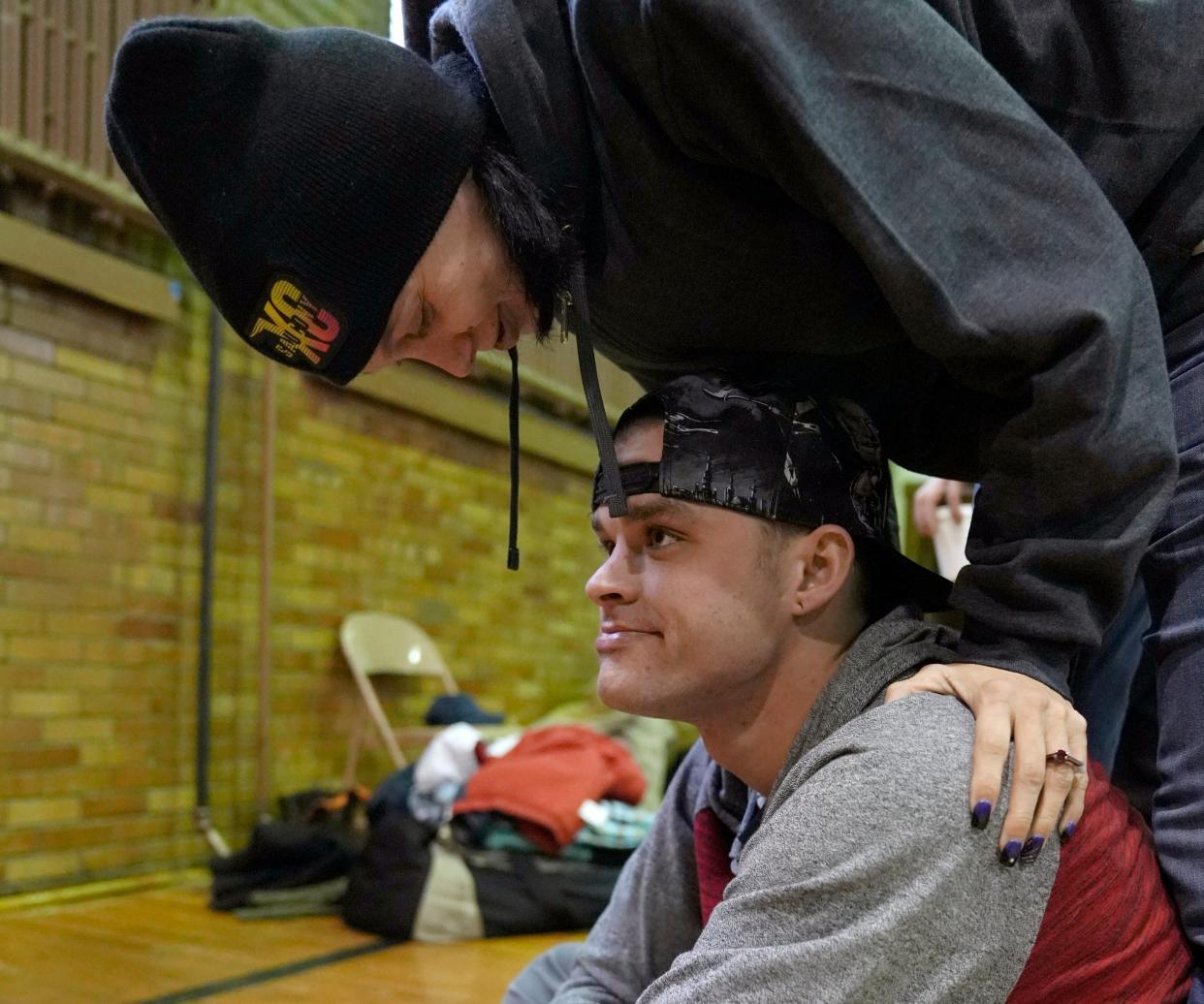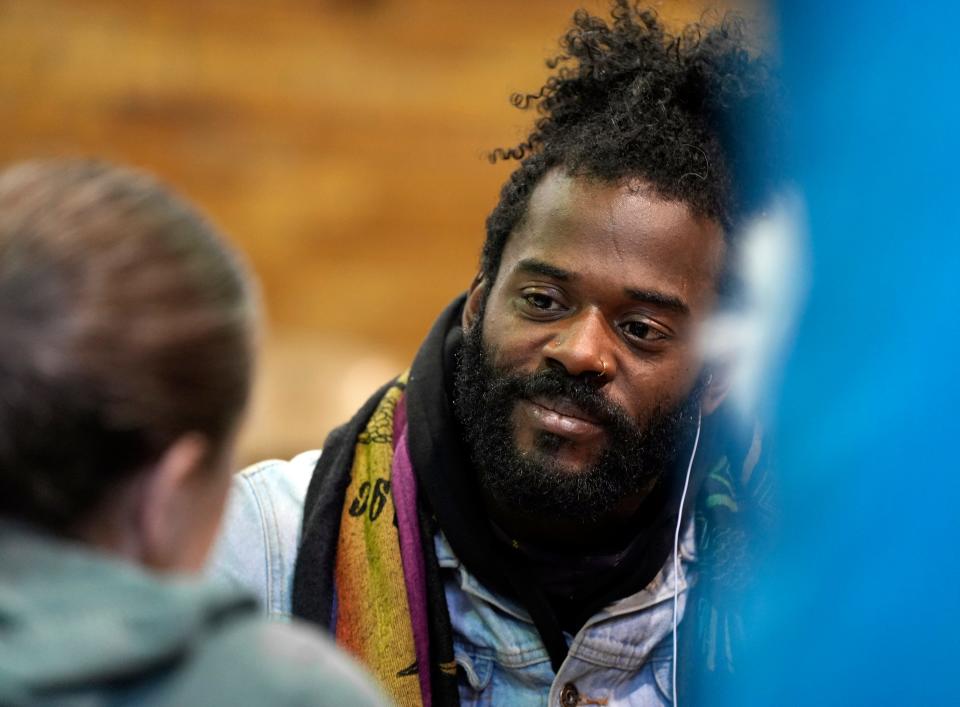Amid annual count, much is planned this year in Columbus to help the homeless find housing

The large belt buckle depicting a bull-riding cowboy peeking from beneath Jerred Mcpherson’s short-sleeve shirt — an award, he said, for winning a competition — serves as one of the few remnants of his previous life in Tennessee.
It's a happy memory amid what was otherwise a fraught time for Mcpherson and his fiancée, Jeana Clark. The couple hoped better times were ahead when they recently moved to Columbus with a promise from a friend of a place to stay. Instead, Mcpherson, 24, and Clark, 40, have spent the past two months living in homeless shelters.
On Wednesday morning, the couple lingered inside the Broad Street United Methodist Church, the site of a winter warming center operated by the Columbus Coalition for the Homeless where they and others facing homelessness can escape the elements.
And on a day when a winter storm brought snow and a cold rain to central Ohio, coalition board member Jim Rose posed the question for public thought: "Where would they go if not here?"
More:Director ousted at Columbus Coalition for the Homeless after procedures not 'adhered to'
This day, the warming center served an additional purpose — as a hub where local homeless advocates could conduct a “point-in-time" count, part of an effort in the Columbus area and in thousands of cities nationwide to get a sense of how many people face homelessness in the United States on any given day.
The Community Shelter Board leads the annual effort in the Columbus area with the support of 20 additional partner agencies, said Sara Loken, community relations director for the nonprofit, which is focused on housing and homelessness. In 2022, 1,912 homeless people were counted.

More:Remaining Latitude Five25 residents relocating after Near East Side towers deemed unsafe
It’s a widely accepted truth among housing advocates that the official point-in-time count — the findings of which Loken said won’t be made public until around April — underestimates the reality of how many people face homelessness at any given time. But advocates also say that Wednesday’s efforts will provide them with a better understanding of the extent of homelessness in Columbus as they prepare for the year ahead.
In 2023, the city of Columbus and many social service agencies are planning to pursue novel approaches — or expand existing ones — to address the housing crisis that has left so many without a place to live.
"(Data from the count) helps us understand what those needs are," said Roxann Payne, manager for social care at Mount Carmel Health, which has an outreach team that visits sites like warming centers to connect homeless individuals to needed services. "It informs how we can work collaboratively as a community to meet the needs."
Promises of more relief to the growing crisis came Tuesday when the U.S. Treasury announced that $690 million in federal American Rescue Plan Act funding would be allocated across more than 30 states for emergency rental assistance to keep people housed, which included $20 million for the City of Columbus and Franklin County.
Rental assistance on hold:Rental assistance applications paused by IMPACT Community Action amid funding uncertainty
In the meantime, advocates worry about those who, without sufficient help, may wind up homeless. And on Wednesday, about 130 people — volunteers, city workers and staff members of social service organizations — fanned out across the Columbus area in an effort to find and tally them.
What is permanent supportive housing:Amid Columbus housing crisis, could more permanent supportive housing be an answer?
They scoured parking lots around the city, looking for people sleeping in cars. They surveyed people coming to soup kitchens and warming centers. And they walked through the streets and known homeless encampments.
The shelter board also made use of a homeless management information system to record the number of people sheltered overnight on Tuesday.
More than 3,000 communities nationwide must submit the point-in-time tallies of homeless adults, teens and children every year to the U.S. Department of Housing and Urban Development. The federal agency uses the information to examine trends across the country that could determine funding, said Marion McFadden, HUD deputy assistant secretary for community planning and development, who was in Columbus to observe the count.

Between the fiscal years 2021 and 2022, homeless shelters in Franklin County served 2% more people overall, and the number of families seeking shelter increased by 19%, according to data compiled by the Community Shelter Board.
“We have vulnerable, vulnerable families out there,” said Shannon Isom, president and CEO of the Community Shelter Board.
Isom touted a pilot program the shelter board oversees that is focused on intervention services before individuals become homeless, like counseling or emergency rental assistance. Out of more than 2,000 families served during the first two years of the three-year program, only 54 ended up in a shelter, according to the shelter board.
The city of Columbus is in the midst of two of its own pilot programs that provide services to homeless people in hopes of connecting them with permanent housing, said Emerald Hernandez-Parra, assistant director of special projects in the city's Development Department.
Beginning in December, the city provided funding for warming centers operated by both the Columbus Coalition for the Homeless and the United Methodist Church & Community Development for All People, places where people can be connected with related wraparound services. The city also continues to monitor the outcome of a transitional housing pilot program started in September when residents of a Near East Side homeless camp were disbanded.
Homeless camp disbanded:City to move remaining residents at Near East Side homeless camp into temporary housing
“It’s really exciting to see it all unfolding,” Hernandez-Parra said. “We hope the community and the city works with us to rally to provide safe space for people who need it.”
Eric Lagatta is a reporter at The Columbus Dispatch covering social justice issues and nonprofits.
elagatta@dispatch.com
@EricLagatta
This article originally appeared on The Columbus Dispatch: Homeless in Columbus: Amid count, what housing strategies are planned?

